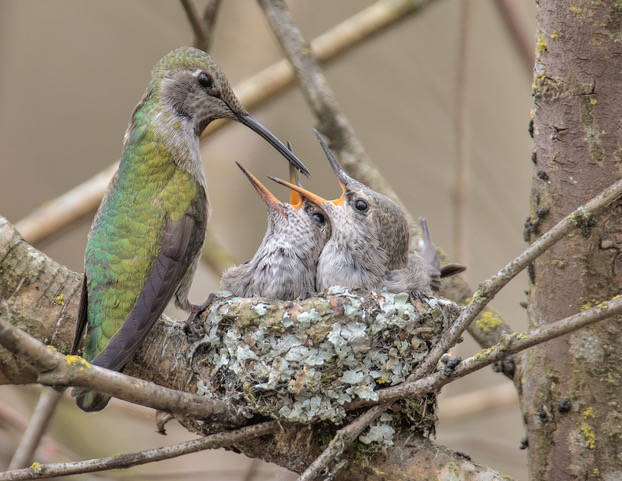
In Native American legend, Hummingbird is a healing spirit, a helper of those in need, and seeing one was a sign of good luck. Hummingbirds are ancient, with fossils suggesting they originated in Eurasia about 42 million years ago, and flew over the land bridge that connected Russia and North America at that time.
Today, they are only found in the Americas.
The Rufous Hummingbird is likely the hummingbird of Pacific Northwest legends. This copper-colored bird — males are all copper, females are copper and green — is renowned for its long-distance migration of 8,000 miles round-trip from deep in Mexico to its breeding ground in the Puget Sound area.
At only 4 inches long (about the length of a finger) Rufous Hummingbirds have the longest known migration as a measure of body length. They regularly fly across the Strait of Juan de Fuca to British Columbia, and have been sighted as far north as Anchorage.
Hummingbird flight is unusual because of their ability to hover, fly backwards or straight up; resembling the wing motion of dragonflies more than other birds. Try it: hold your elbows at your sides with your forearms extended in front parallel to the floor. As you wave your forearms in and out, turn your palms at the wrist so your “wings” make a figure of eight pattern.
These rapid wing movements (50 times per second) gives the hummingbird lift on both forward and backward strokes and combined with a light weight (3.4 grams, about the weight of a penny and a half), make it very agile.
Lots of high-energy fuel is required; they feed 5-8 times an hour on nectar (sucrose) or hummingbird feeders (also sucrose: mixed one part white sugar to four parts warm water).
With a heart rate of an astounding 1200 beats per minute, they fly at normal speeds of 20-45 miles per hour, except during courtship dive displays where they fly 100 feet up and dive to earth, only to quickly pull out of the dive and climb again. The force on their bodies reaches 9 Gs (the force of gravity) during these flight maneuvers, similar to a full-throttle F-16.
The Rufous Hummingbird is as an aggressive defender of feeding and breeding territory in the Pacific Northwest, but a revolution began around 1994 with the arrival of another territorial hummingbird species, the Anna’s Hummingbird. Iridescent green, with the male sporting a glowing red throat patch in a certain angle of light, the Anna’s are slightly larger (4 grams) and many stay in our temperate region year-round.
Originating in southern California, beginning in the 1930s these birds took advantage of human gardening and hummingbird feeders to extend their range northwards.
There are now about 300 overwintering Anna’s Hummingbirds counted on the Sequim-Dungeness Christmas Bird Count each year. Anna’s begin breeding and nest-building in early spring before the Rufous arrive.
Hummingbird females construct their nests by weaving lichens and moss together with spider silk to form a tiny cup. The two eggs are jellybean-sized. The spider silk can stretch, and as the young birds grow the nest expands with them.
Try to spot a nest in your yard this month by following the frequent feeding trips of the female.
Hummingbird, the healer of legend, helper to those in need and bringer of good luck is warmly welcomed in our community this month as we look to our birds with thoughts of hope and healing.
Judith White is President of the Olympic Peninsula Audubon Society.
"bird" - Google News
May 13, 2020 at 03:30PM
https://ift.tt/2SYxXDi
Bird Tales: The hummingbird's tale - Sequim Gazette
"bird" - Google News
https://ift.tt/2s1zYEq
https://ift.tt/3dbExxU
Bagikan Berita Ini














0 Response to "Bird Tales: The hummingbird's tale - Sequim Gazette"
Post a Comment